Nutrition team serves up ‘super githeri’ and positive food messages
Posted on June 13, 2018
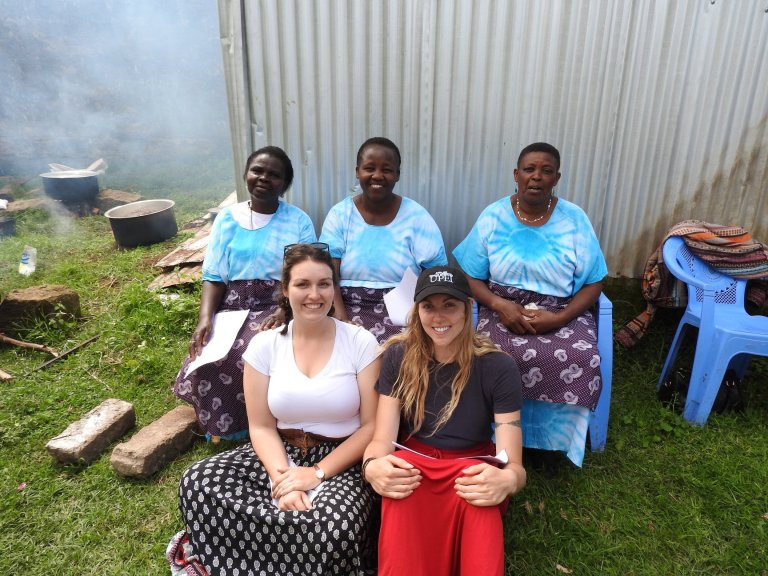
L-R: Hannah Creaser and Madison Brauer, Queen Elizabeth Scholars nutrition interns, and 3 of the Joy women’s group members who helped cook, serve and teach!
Hi everyone! Hannah and Madi here- the 2018 nutrition interns working with Farmers Helping Farmers and Queen Elizabeth Scholars.
Monday, May 28 was a very busy, exciting and fun filled day working with the folks at the Naari dairy. When we learned about an all day dairy seminar at the Naari Dairy Farmers Cooperative Society, a key partner of Farmers Helping Farmers (located nearby), the nutrition team seized the opportunity to speak in front of over 500 farmers!
Since the dairy was providing rice to the participants after the seminar at 2 p.m. (with a small amount of beef), we decided to add a small (1/3 cup) of healthy ‘super githeri’ to the meal so that we could reinforce our nutrition messages.
In case you haven’t heard of it, ‘super githeri’ uses whole grain (mpempe) maize, soaked maize and beans to soften them and improve nutrient availability, a 1:1 ratio of maize and beans to increase protein, and at least one green and orange vegetable.
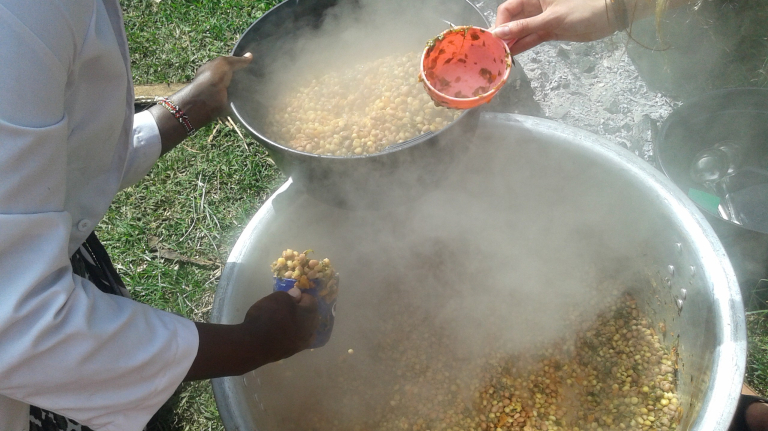
“Super” githeri
We decided to use a small portion so that the work would be doable in one morning, and would not require more space to cook.
On Sunday, we got the 10 kg of maize and 10 kg of beans from a local market, and spent a good amount of time removing the small stones from the beans before we soaked them overnight at the dairy.
We then spent the morning at the dairy preparing the githeri with our leaders or “champs” from the Joy women’s group. Preparing the githeri was a fantastic but exhausting experience as it involved being surrounded by 10 open pit fires that were constantly billowing smoke into our eyes, the hot African sun beaming down onto our sensitive Canadian skin, and learning to chop numerous kilograms of vegetables without a cutting board (minor cuts and blisters formed!).
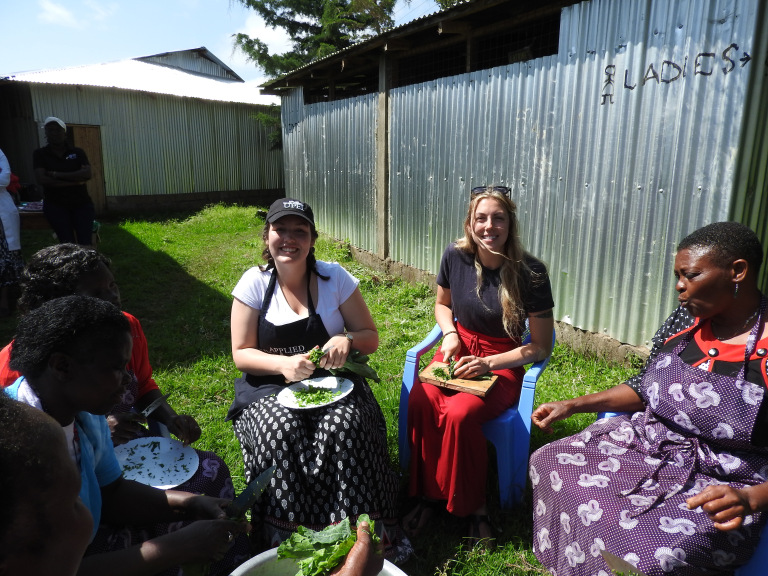
Hannah Creaser and Madison Brauer getting lessons on how to cut kale the Kenyan way.
Working with the Joy women’s group was an excellent experience: if it weren’t for them, the githeri likely wouldn’t have come together, and would be nowhere near Kenyan standards in terms of taste and texture. The women taught us the ins and outs of Kenyan githeri and were patient with us as we struggled to cut the carrots as thinly and precisely as they were. The women treated us like their pupils and were happy to pose for many photos with us.
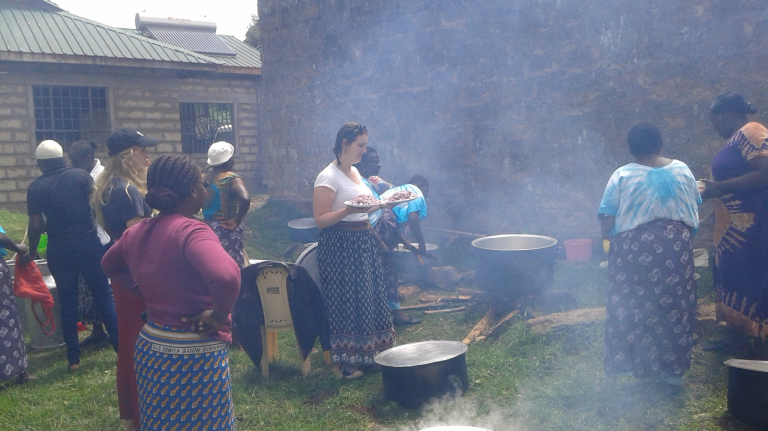
Smoke billowing from the many pots of rice and the large pot of githeri that were cooking
The seminar started an hour late-at 11:00 a.m.- so our presentation time was moved from 1:00 to 2:00 p.m. When it came time to speak, the group of us filed in to the hall and were very warmly greeted.
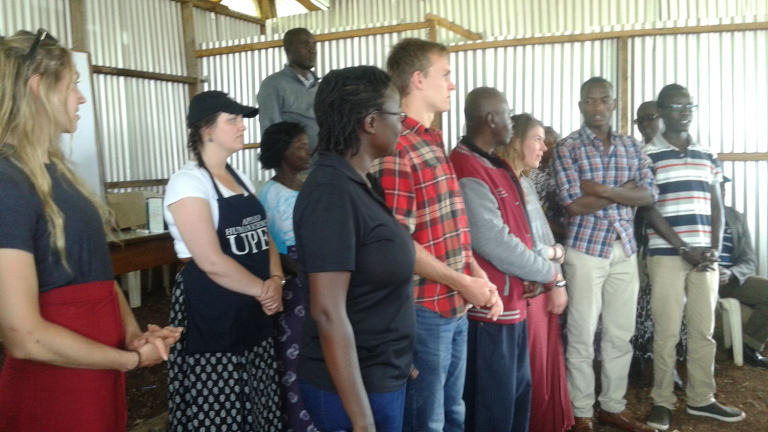
Introducing the vet and nutrition teams, and the Joy women
The start of our presentation went smoothly and uninterrupted. After our prof Jennifer introduced the session, Hannah stood up and received some laughs when talking about avoiding traditional tea at mealtimes to increase iron absorption.
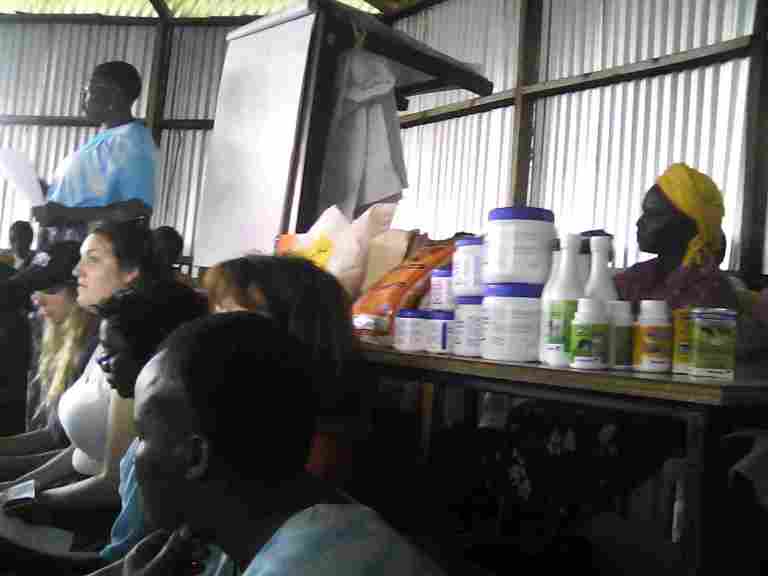
One of the new 2018 champs presents one of the messages
Salome, one of our Farmers Helping Farmers employees was there not only to help organize the seminar and food preparation, she also was invaluable in translating our messages from English to Kimeru to ensure that everyone in the audience was understanding them. She was an amazing help since she knew the women well and the dairy group.
It was not until Esther, the chair lady of the Joy women’s group stood up to discuss having a 1:1 ratio of maize and beans in githeri did people in the audience start hissing and booing. Traditionally, the ratio of maize and beans is 2:1 in githeri, and although this may not sound like a huge change to us Canadians, I equate it to someone telling me to use whole wheat noodles in my Kraft Dinner for health reasons (not happening!)
It was a great example of how there is so much culture entangled in the food that we eat, and that our food culture is not easy to change. After Jen, our prof, got up and reinforced what Esther had said, those objecting seemed to calm down.
Madi was the fifth speaker to deliver a message on mukimo, which is a dish comparable to mashed potatoes. She again reiterated messages such as using a 1:1 ratio of maize and beans, adding greens, and adding a source of vitamin C to the dish to increase iron absorption. This time it was better received.
After the messages had been delivered, Sarah Muthee, a recent Master of Science in nutrition grad from UPEI, stood up and spoke about her research findings.
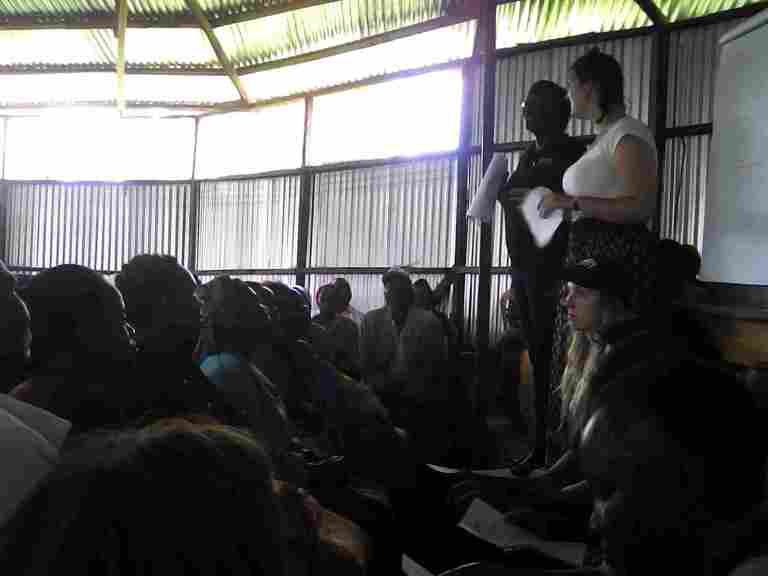
Hannah speaking to the large crowd with Salome translating English to Kimeru
Again, people were eager and interested to learn what she had found for results. For both of us (Hannah and Madi’s), it was our first time talking in front of that many people. It was nerve wracking, but also incredibly exciting! It was such an amazing opportunity to reach so many people in the community with our nutrition messages AND let them taste the food as proof healthy food can taste good.
After our presentation wrapped, we served the super githeri that took almost a full day to prepare. There were two lines: one for men and one for women.
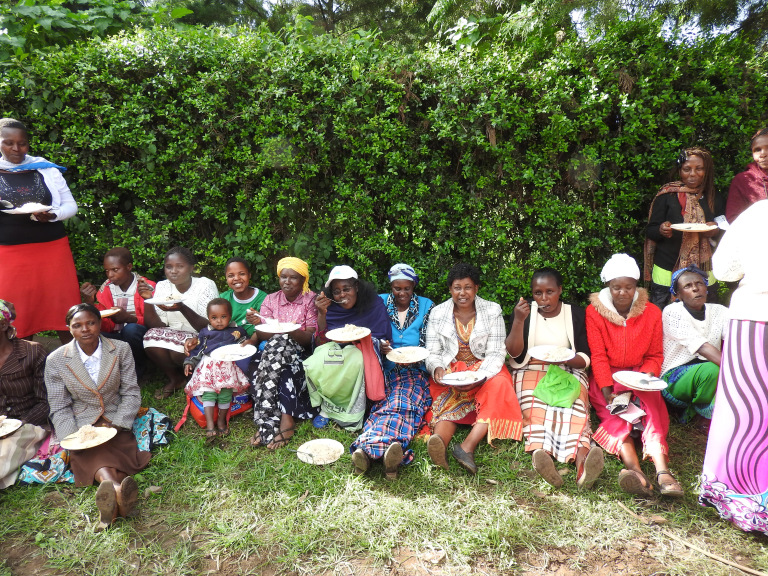
A group of dairy women enjoy their food after the dairy seminar
It was wonderful to walk around after serving to watch people enjoy our dish, especially the women who would benefit most from the higher iron content.
Overall it was a hit, and we received a lot of positive feedback. All the work and stress was well worth it!
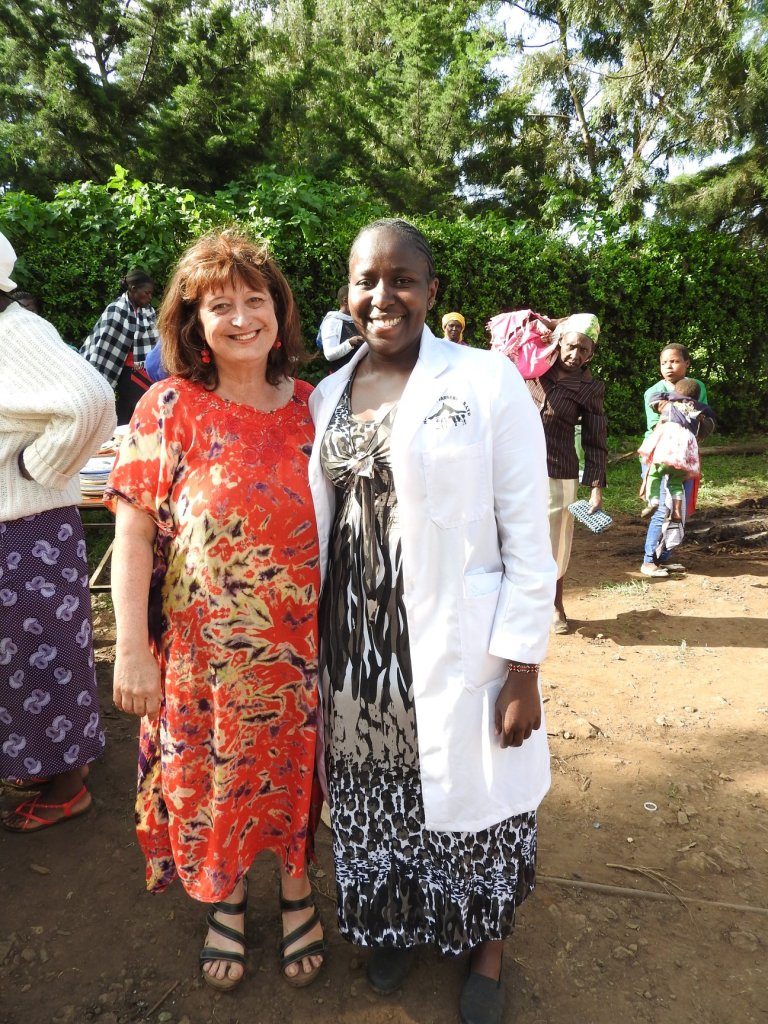
Sarah and Jennifer- Sarah just completed Master of Science in Nutrition!
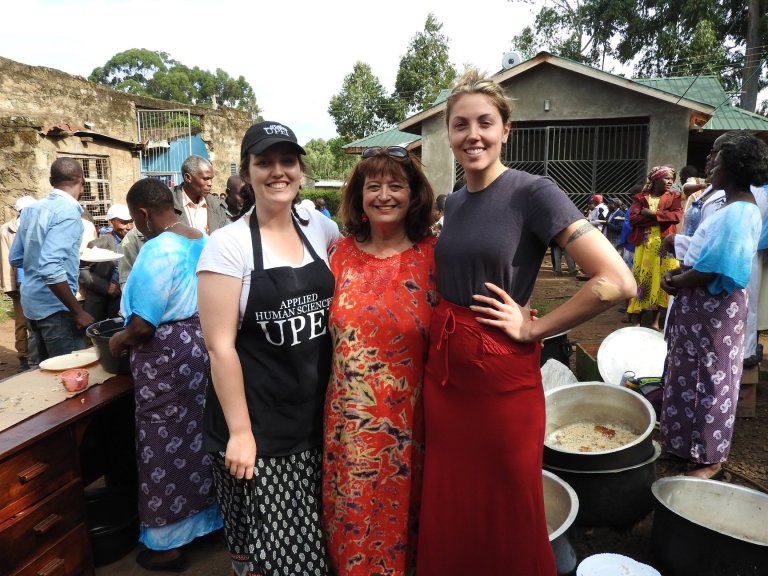
Hannah Creaser, Dr. Jennifer Taylor and Madison Brauer smiling after a successful day
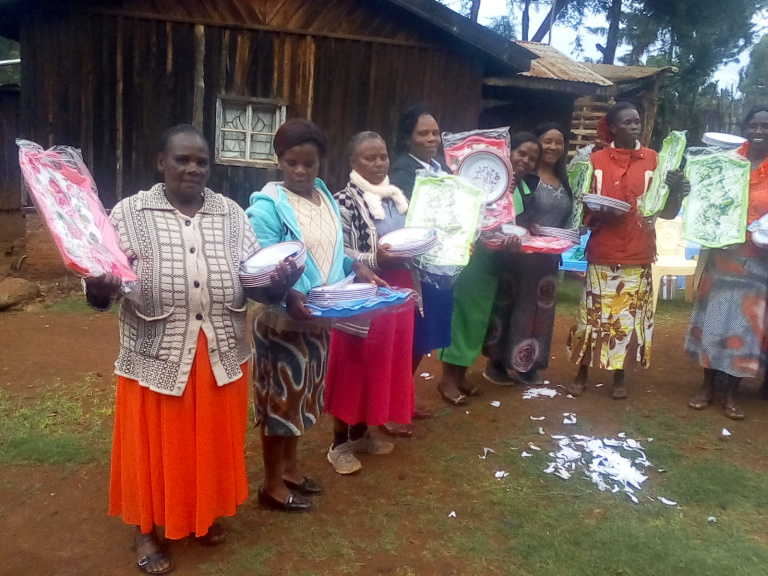
Joy women head home after a very busy day!
Canadians fight the Kenyan cold
Posted on July 9, 2018
by Madi Brauer
Illness has struck the intern home last week, as Ashley came down with a bad cold and was bed ridden for a day. The next to catch the cold was Hannah, who spent many days coughing and sniffling at home interviews and school assessments/seminars. I personally thought I had dodged this bullet, as many days passed after the two girls fell ill, and I still felt fine. I was wrong!
After our long drive to and from Nkando primary school for the assessment, I developed all of the classical symptoms of a cold. I believe the dusty dirt roads were a catalyst to my chest congestion that quickly formed that evening. I required one and one-half days of bed rest, leaving Hannah and Sarah to conduct a school seminar without me, before I regained my strength. Ashley, Hannah and I are all now on the mend, each of us only sniffling and coughing a few times a day. We were hopeful that the worst was over, and that this Kenyan bug had left the household for good. That is—until Sarah lost her voice!
As I sit here now writing this blog post, Sarah sits next to me sipping “dawa” (ginger, garlic and lemon tea) unable to speak due to the congestion in her throat, Ashley and Hannah leave the room periodically to cough and sniffle while they sit, and Lee sits working on his laptop, perfectly healthy. We are all waiting for this cold to take its next victim; will it be Lee or Remmie?
Despite the irritating cold symptoms, we are all in good spirits and enjoying Kenya and all of its experiences. On Sunday, we took a trip to the Lewa conservancy with Salome, an employee of Farmers Helping Farmers and hiked to an amazing waterfall.
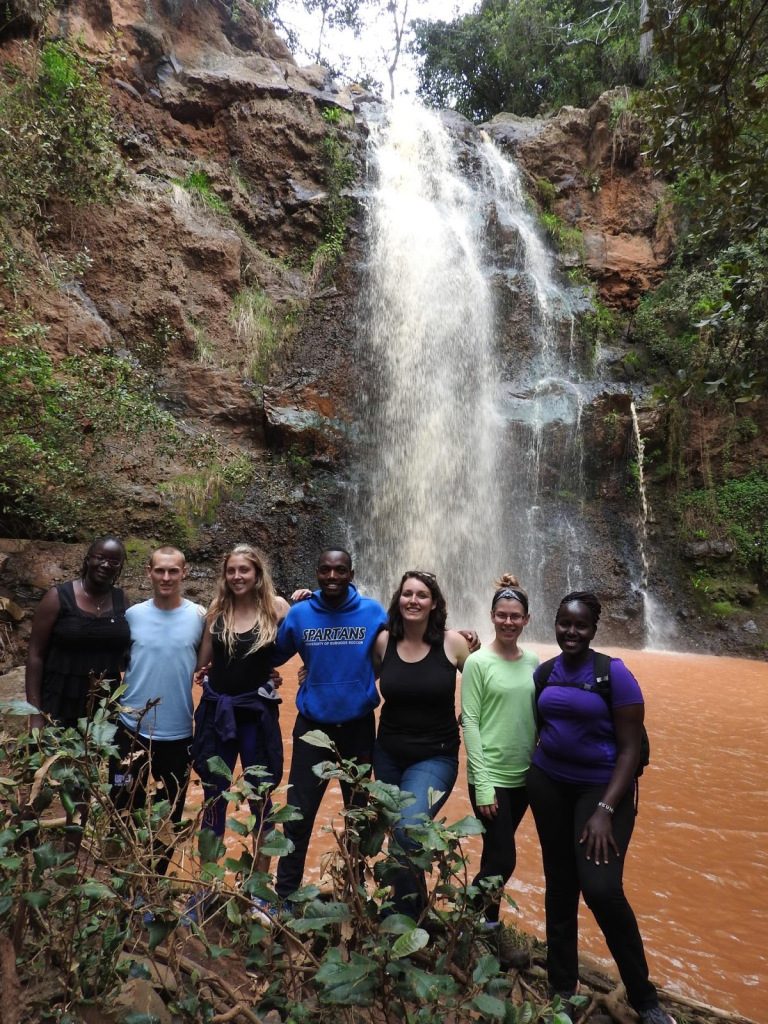
From L-R: Salome (Farmers Helping Farmers), Lee (vet team), Madi (nutrition team), Remy (vet team support), Hannah (nutrition team), Ashley (vet team), Sarah (nutrition team support)
Half of the group nearly ‘hacked up a lung’ from all of the hill climbing, but we all had an amazing time and got to hear an elephant far off in the distance trumpet; an experience Ashley and I crossed off of our bucket list!
This Kenyan cold cannot keep these Canadians down!
Madison Brauer
Learning on the farm
July 10, 2018
by Hannah Creaser
This is Hannah from the 2018 Nutrition team. Every day that I spend here I am fortunate enough to learn something new and one day last week was no exception! On Monday, the nutrition team had the opportunity to spend the day with the veterinary students visiting local farms. I walked into this experience knowing almost nothing about dairy cows and actually managed to walk away with a fair bit of knowledge! Growing up in rural New Brunswick, I was often around farms but never actually had the opportunity to visit one so this was a very exciting opportunity for me.
The first farm that we visited had an eager farmer named Gatwiri, who spoke very good English. She was excited to hear that we were students as she herself had taken agriculture at a local college so she wanted us to get the most out of the visit as possible. She was the very proud owner of three cows and a calf and said that she had hired people at one point to take of them, but wanted to make sure that they were getting the best care possible so she took over the job herself. Lee, Ashley and Remmie (a veterinarian who is works for Farmers Helping Farmers) discussed nutrition, cleanliness, reproduction and the comfort of the cows with Gatwiri.
The vets soon learned that two of her cows had not shown signs of heat in several months and it was determined to be because the cows were too thin. Remmie and Ashley performed a rectal exam to determine if the cow was going to be ovulating soon or not. It turned into a very exciting moment as Ashley actually found her ovary during a rectal exam! I think I can speak for all of us that we were extremely proud of her. I was just happy to be there to snap a picture of the moment.
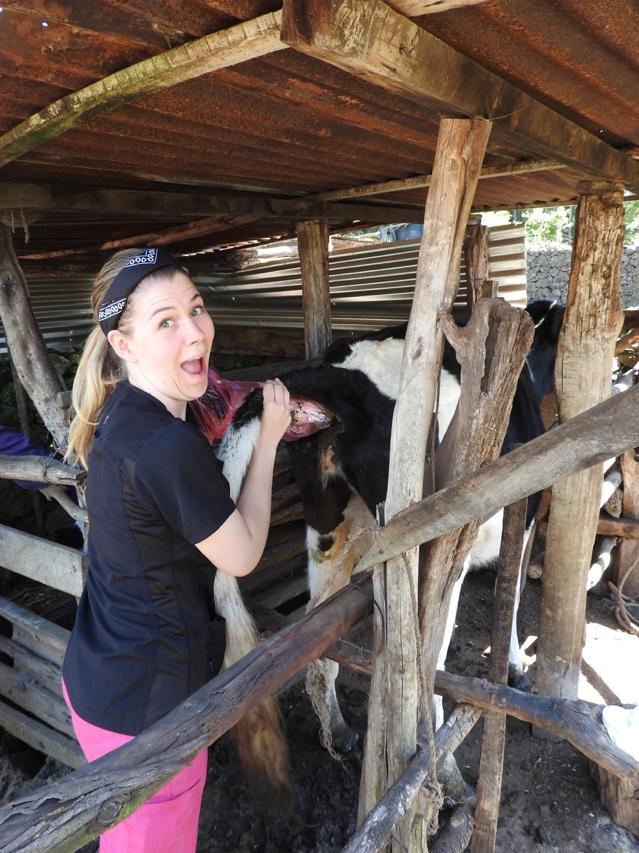
Ashley performing a rectal exam on the cow to see if she was going to be ovulating soon. This was the first time that Ashley was successful find an ovary.
After the rectal exam was complete, the vets wanted to check the cows for mastitis, which is done by collecting a small sample of milk from each teat on the cow and then adding a solution which will cause the milk to gel if positive. Lee offered to let both Madison and I collect a sample from a teat. As it was my first time milking a cow, I needed a little bit more direction than some of the others; however, after a few attempts I was successful!
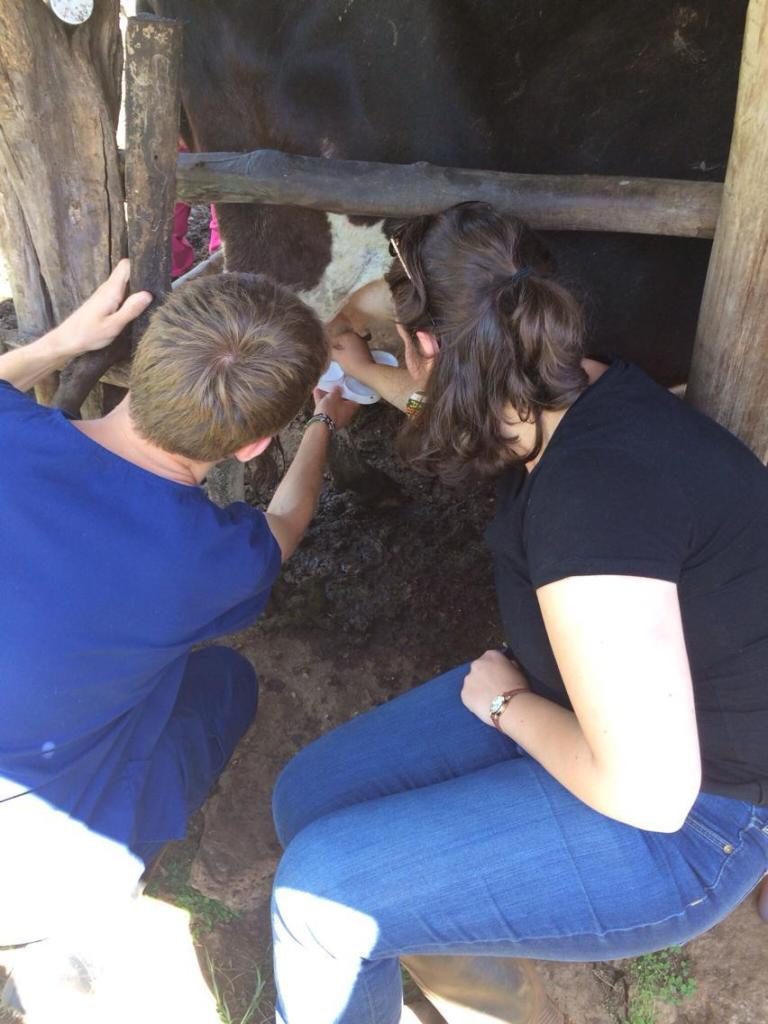
My first experience milking a cow
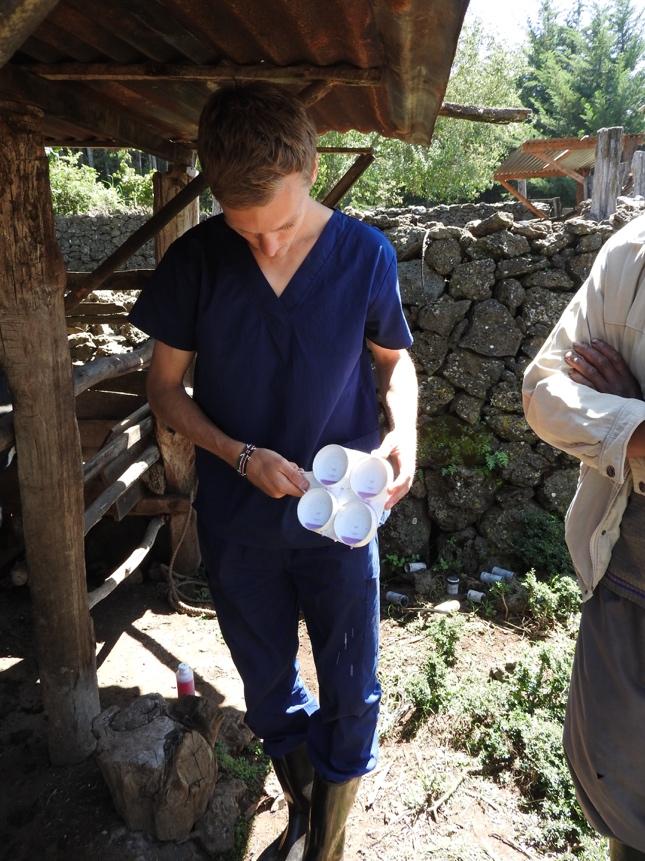
Lee checking for mastitis, the cow tested negative
As we were wrapping up the visit, we all wanted a photo with Gatwiri. Although we went to other farms that day, this farm- and this farmer- in particular stood out to me not only because she was so kind, but also because she was so genuinely interested in not only her own learning, but also ours.
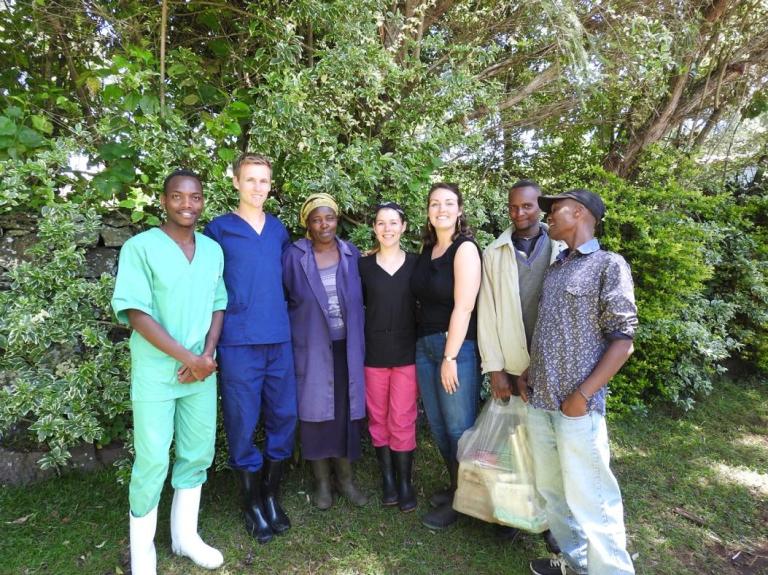
One last photo with Gatwiri before we left to go to the next farm. Missing Madison who graciously took the photo.
This opportunity spent visiting farms was a wonderful example of the many inter-professional/ learning opportunities that have presented themselves to us during our internship here. One thing that I have realised is that no intervention is completely separate from another. So when the vets go visit a farm to talk about ways to get the most milk from the dairy cows, it means that they can sell more milk to the dairy and that they and their children can drink it more milk! When a farmer is able to sell more milk to the dairy, it means that she/he has additional income. If they have additional income, it means that they can buy more food, which is where the nutrition team comes: we provide education on which foods are nutritious (or not) and how to prepare healthier meals from the food they grow and buy. I have really come to realize that even when our interventions seem very disconnected, that they are actually integrated and, together, can make a difference for rural Kenyan farm families.
August 1, 2018
by Hannah Creaser
Hello everyone, Hannah checking in again. We’ve had a busy few weeks here!
It is always difficult to get back into the groove after vacation. The first week of July we visited Mombasa, which is a city located on the coast. This was my first time swimming in the Indian Ocean. Mombasa was beautiful and warm, which was a nice change from the Naari region which is quite cold right now. The months of June and July is the cold season here in Kenya, which means grey skies, foggy and an average temperature of 15 degrees Celsius. Thankfully, we are just now coming out of our cold season and back to enjoying sunny and warm Naari!
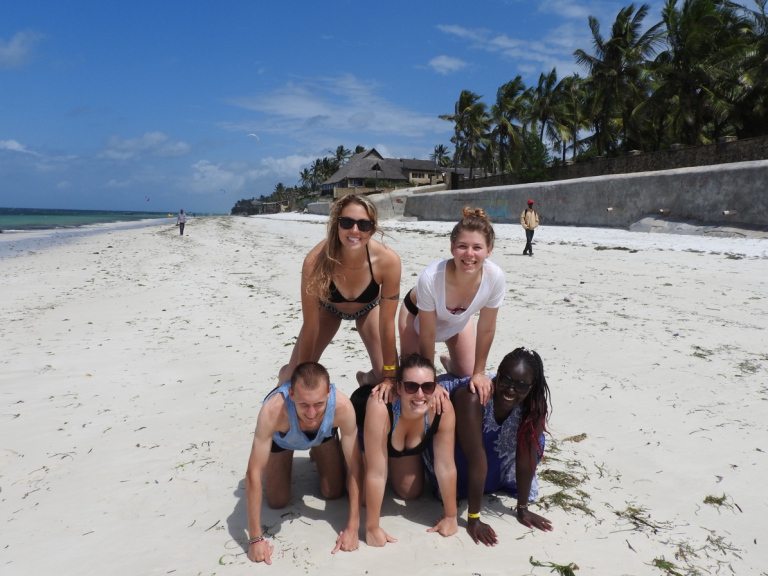
Madison giving me a quick piggyback. You could say that we were excited to be handing in our last school report.
For this seminar, the teacher had told us to expect 20 to 30 parents, so we were thrilled when we walked in and there were 70 parents! This was also the first time that these parents had heard these messages. The parents asked so many great questions about iron deficiency, proper soaking techniques for maize and beans and more. It was a dietetic interns dream come true to get to share so much nutrition knowledge.
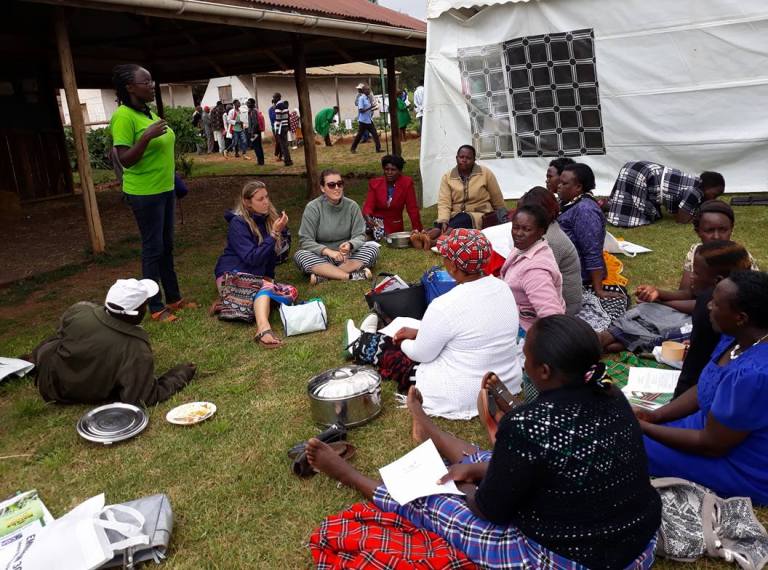
Madison up sharing some of the nutrition messages with Salome (a Farmers Helping Famers employee) translating. Without Salome, these seminars would not have gone as successfully as they did.
This past weekend, I had the honour our receiving my Kimeru name. Here in Meru County, people are given a Kimeru name (Kimeru is the local dialect) either based on their personality traits or they inherit their grandparent’s name on their father’s side. Steven Mwenda from Farmers Helping Farmers and Remmy, a Kenyan vet supporting the vet student team, are two wonderful friends of the team: they decided that I should be called Makena, which means that one that is joyous or always happy. The locals always have a good laugh when we introduce ourselves using our Kimeru names.
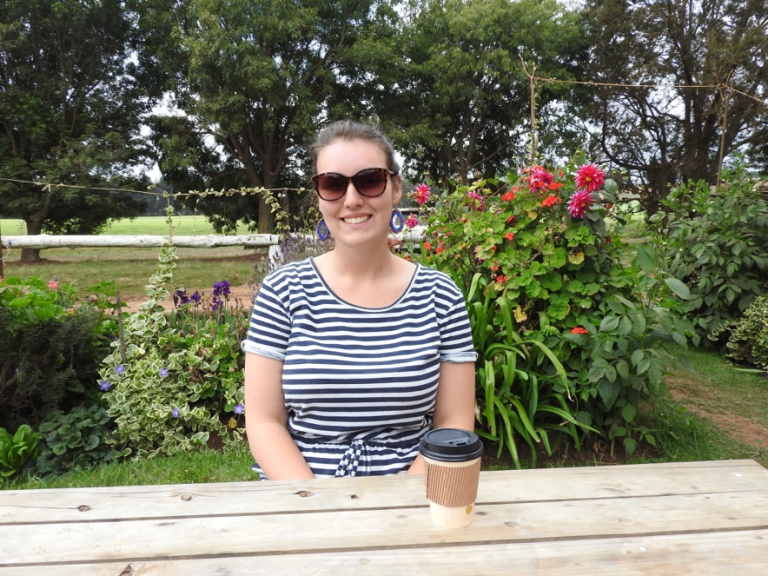
Hannah (Makena) is always happiest with a good cup of coffee in hand.
Until next time everyone!
Hannah Makena
